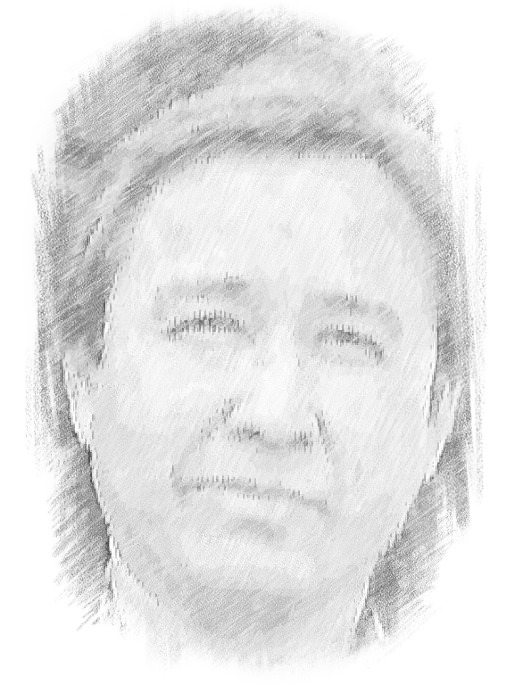
David Johns
(b. 1948)
David Johns was born in Winslow, Arizona. Johns received formal training in fine arts from Northern Arizona University, earning a Bachelor’s Degree in 1982. In 1996, he was awarded an Honorary Doctorate Degree in Humane Letters from Northern Arizona University.
Johns started selling portraits and landscapes while still in high school. His work combines his formal training with the traditional teachings he learned as a child and the Navajo philosophy of life by which he lives. The symmetry of his paintings reflect this harmony and balance; the colors and textures he creates reflect the beauty of the land from which he comes. His abstract paintings capture life’s subtle phenomena such as the sunlight at different times of the day or the emotions brought by each of the four seasons.
In 1987, Johns was approached by long-time mentor Lovena Ohl and Albert Wareing to paint a mural on the dome of Concord Place. The mural covered thirty-six feet in diameter and rose 50 feet in the air, and took 18 months to paint. The mural depicts native peoples in all four directions, presenting indigenous designs and symbols, and portraits of great leaders such as Crazy Horse and Quanah Parker.
Beginning in 1976, David’s work has been exhibited at gallery shows all over the world, with many solo exhibitions including Navajo Tribal Museum, Window Rock, Arizona (1977); C.G. Rein Galleries, Santa Fe, New Mexico (1984); The Concord Place, Phoenix, Arizona (1987); Millicent Rogers Museum, Taos, New Mexico (1993); Palais de Nations, United Nations, Geneva, Switzerland (1999); and the Lanning Gallery, Sedona, Arizona (2006).
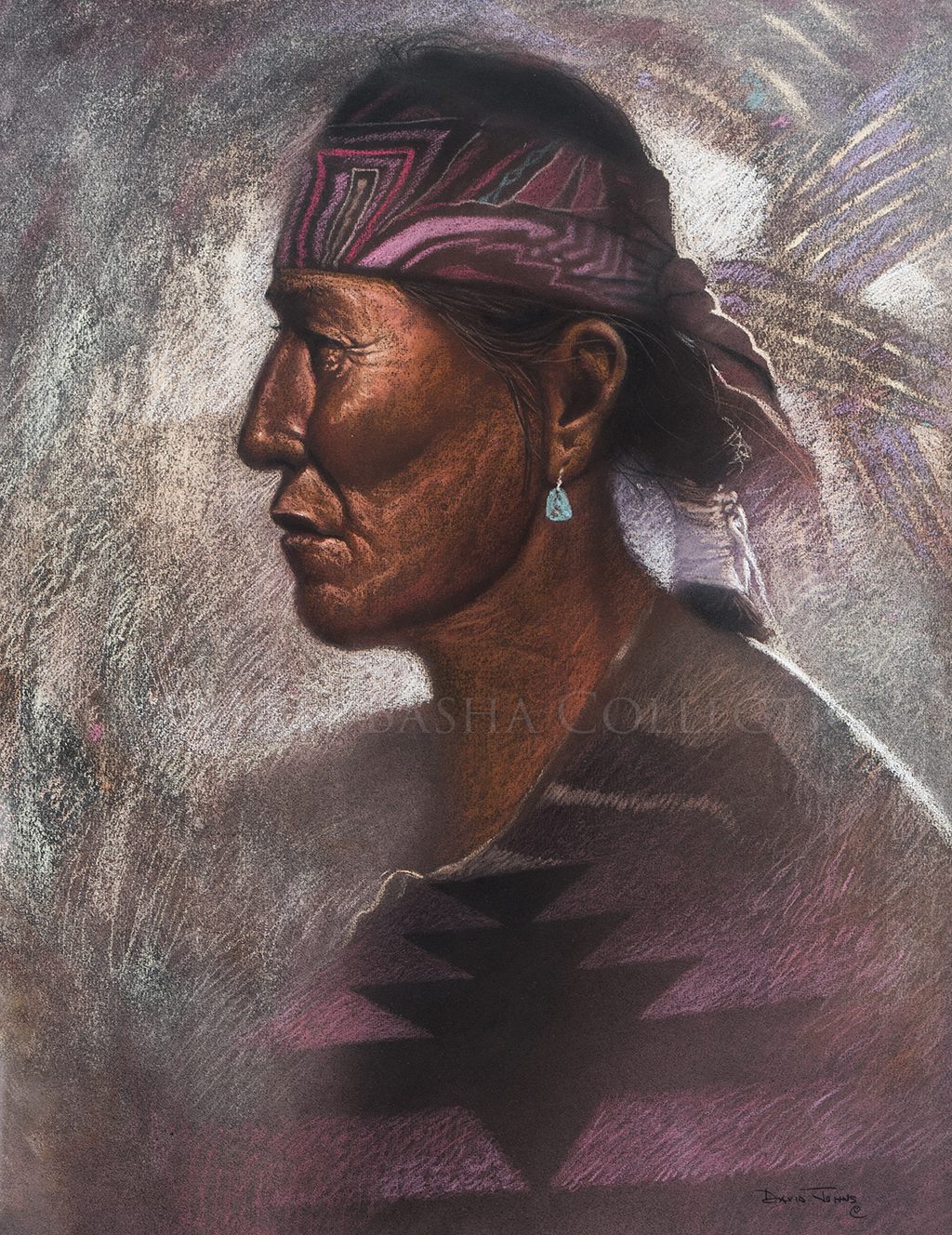
Unknown Title
Artist: David Johns (b. 1948)
Description: Pastel | Image Size: 24”h x 19”w; Framed Size: 32 ½"h x 27 ¼"wpastels
This pastel portrait by David Johns features a somewhat elderly yet strong Navajo male profile whose face shows telltale signs of spending time outdoors as evidenced by the deepened tones of his complexion. It also includes hints of the subject’s celebration of his culture as noted by both the strong symbolism shown in his head wrap and the blanket he is swathed in. The turquoise drop earring takes center stage and is another celebration of culture which dates back centuries. Earrings can denote tribal identity, an individual’s spirituality, and are often worn during other traditional rituals such as a coming of age or rite of passage ceremonies which still take place today.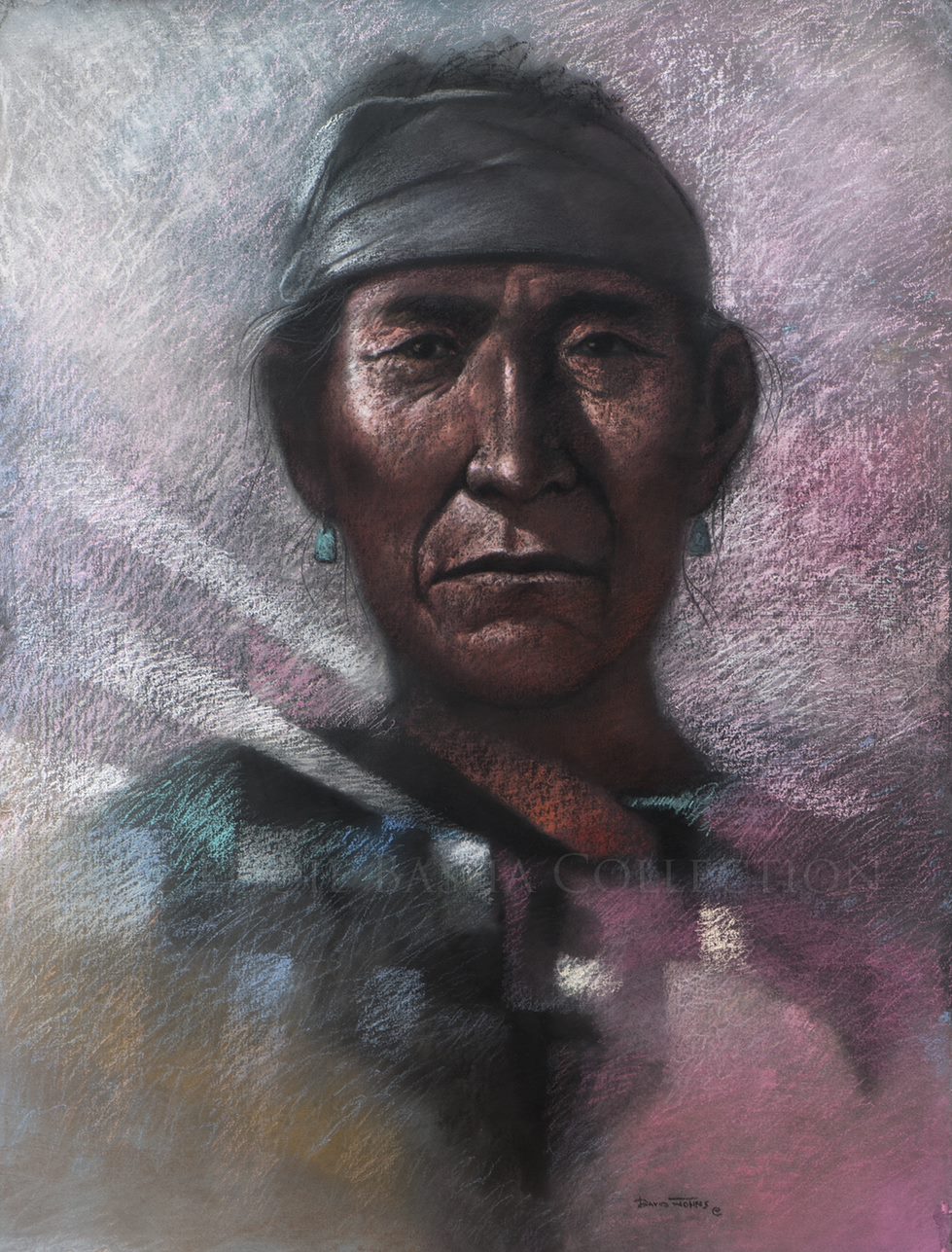
Unknown Title
Artist: David Johns (b. 1948)
Description: Pastel | Image Size: 30”h x 22”w; Framed Size: 45”h x 38”wpastels
“My creations on paper or canvas do not come from a place of preconception. They come from the inner most chamber of my soul. The essence of what I am is a spiritual being. I am a Diné (Navajo) man of the Tl’a’a’shchi’I’ clan and born for the Kiiya’’aannii clan. Even as I write it, it feels like I am saying a prayer.
Everything I am and do I hope comes from a place of harmony. If my mind, body and spirit are in balance then I can produce an image which reflects my truth. I hope my abstractions are ways for the observer to feel the essence of my inner self; not to get caught up in the distractions of outer appearances. It is not the form that touches our deepest longings, but rather the story my images evoke in the viewer. This is the ultimate impact of my art,” opined David Johns.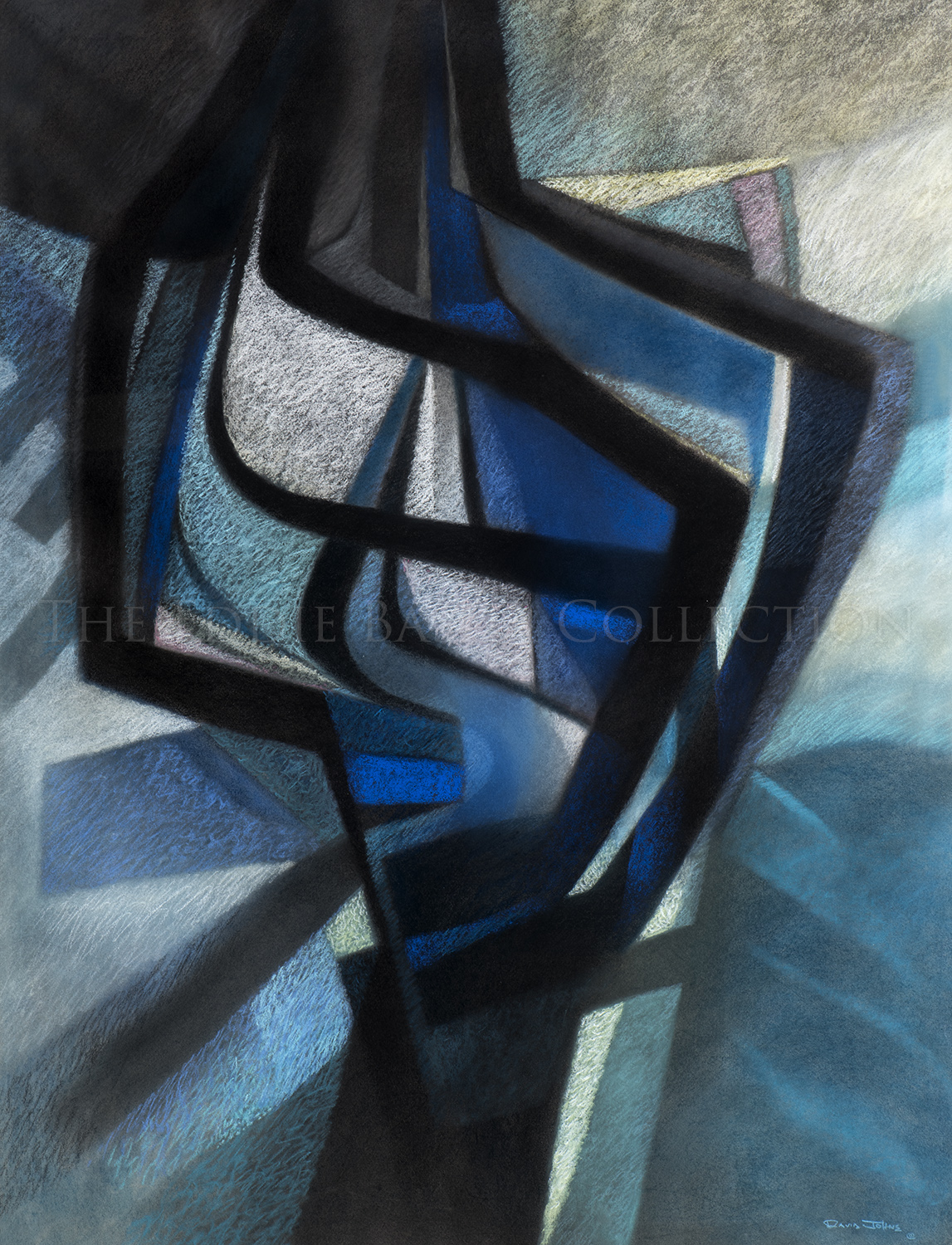
Figure in Robe
Artist: David Johns (b. 1948)
Description: Pastel | Image Size: 38”h x 30”w; Framed Size: 46”h x 37”wpastels
David Johns is a prolific Navajo artist who moves easily between two distinct styles: representational portraits and abstracts. As a result, his work appeals to a wide range of collectors. Thus far, the EBC has only shared Johns’ work in acrylic and a few monotypes. Today it is our distinct pleasure to share this pastel abstract that remains a permanent part of the collection.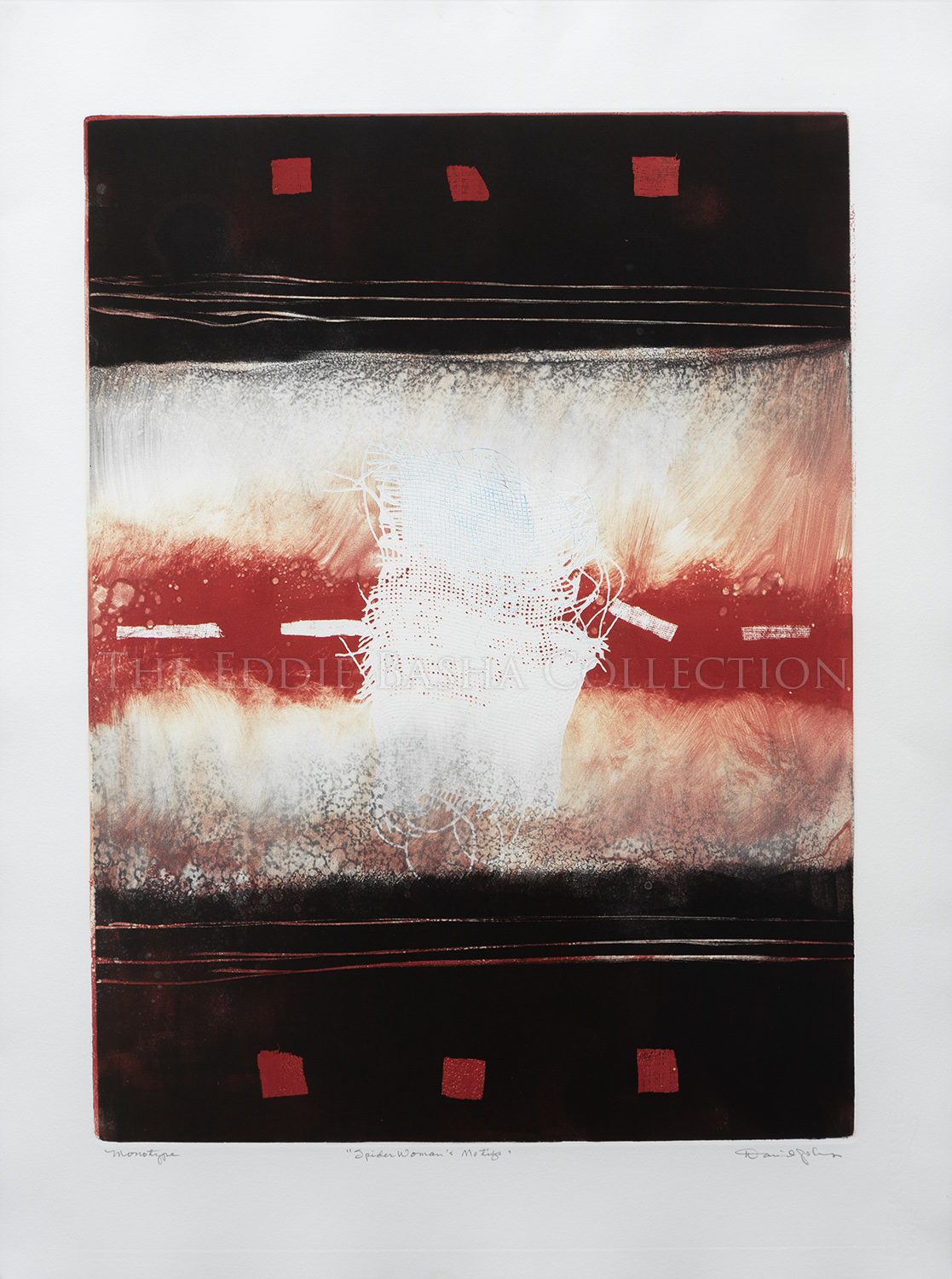
Spider Woman’s Motifs #3
Artist: David Johns (b. 1948)
Description: Monotype (2004) | Image Size: 30”h x 22”w”; Framed Size: 38 ½”h x 31”wpainting
Johns’ work is inspired by his Navajo culture, traditional healing practice, wisdom and being an herbalist. In the Navajo culture, Spider Woman is revered for sharing the wisdom, education and skills the first people needed to survive, such as planting crops and weaving.
Spider Woman’s Motifs #1
Artist: David Johns (b. 1948)
Description: Monotype (2004) | Image Size: 30”h x 22”w”; Framed Size: 38 ½”h x 31”w
Johns’ work is inspired by his Navajo culture, traditional healing practice, wisdom and being an herbalist. In the Navajo culture, Spider Woman is revered for sharing the wisdom, education and skills the first people needed to survive, such as planting crops and weaving.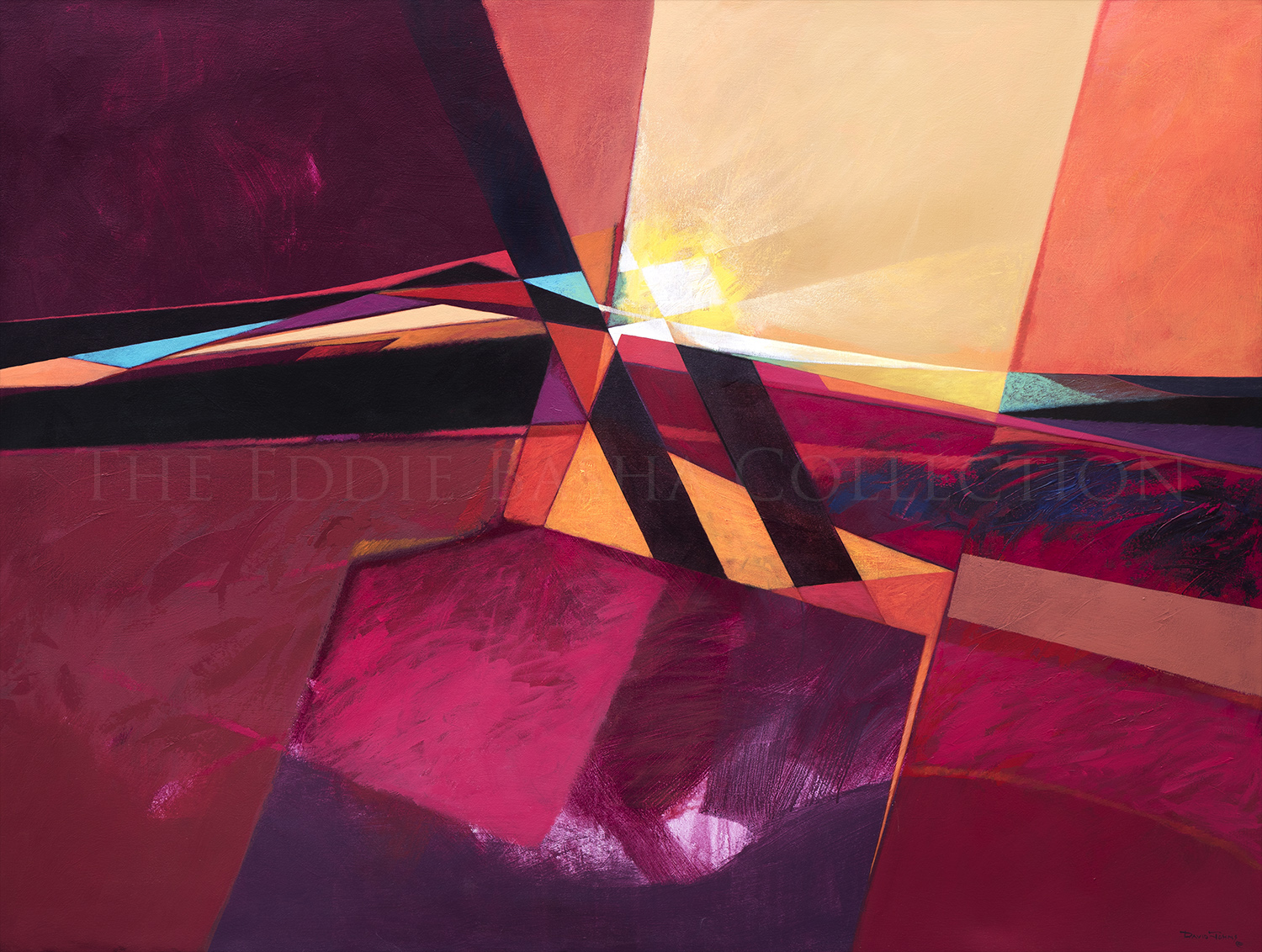
Landscape
Artist: David Johns (b. 1948)
Description: Acrylic | Dimensions: 54”h x 72”w; mounted on stretcher barspainting
Another vibrant, abstract masterwork titled “Landscape” by Navajo artist, David Johns, features the brilliant colors of a glorious sunset descending beyond the mountain tops.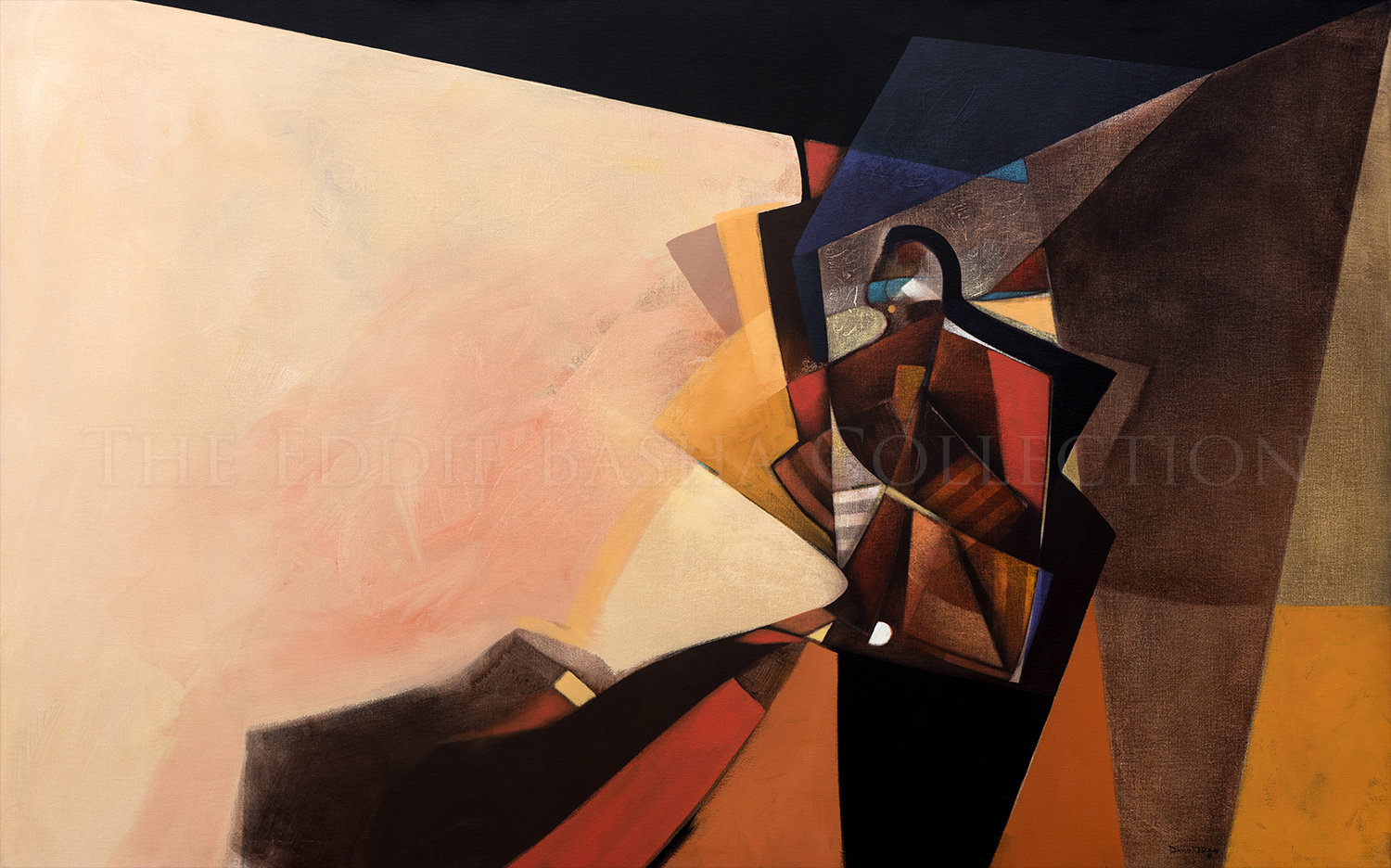
Alone
Artist: David Johns (b. 1948)
Description: Acrylic (1990) | Image Size: 44”h x 70”w; mounted on stretcher barspainting
In the book, “David Johns: On the Trail of Beauty” written by Lois Essary Jacka published in 1991, David John’s shared the following about this piece: “It expresses emotion when alone in the great outdoors. A sense of serenity comes with the silence, the gently shifting sands, the muted call of a bird, the sigh of the wind. Yet with the serenity comes the feeling that someone, perhaps an ever watchful spirit, is close at hand.”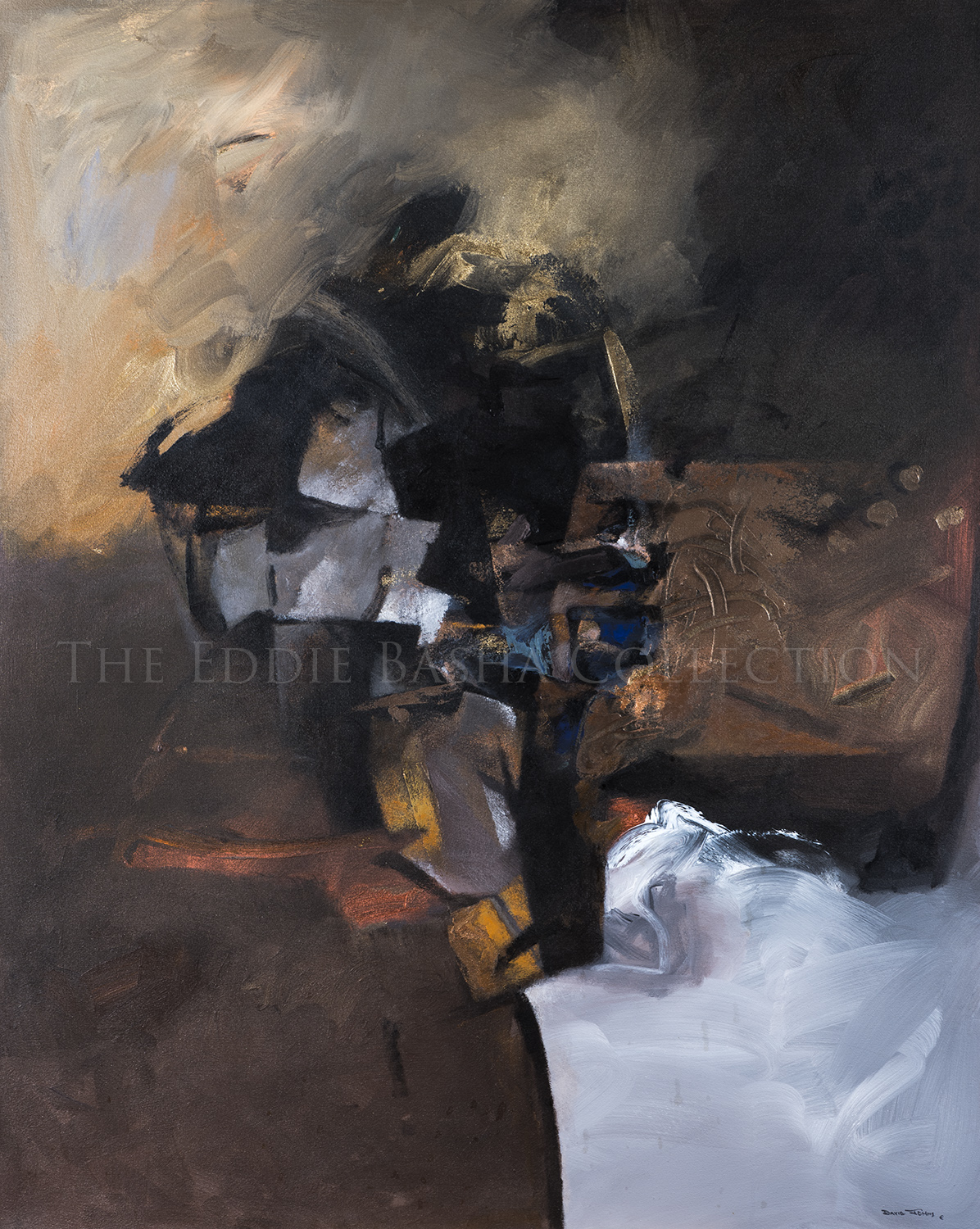
Manifestation Insight
Artist: David Johns (b. 1948)
Description: Acrylic on Canvas | Image Size: 60”h x 48”w; mounted on stretcher barspainting
David Johns shared that his masterwork “Manifestation Insight” was a compilation of stories pertaining to the stars that give us knowledge, wisdom, sensory perception and auditory projection.
Johns’ work is inspired by his Navajo culture, traditional healing practice, wisdom and being an herbalist.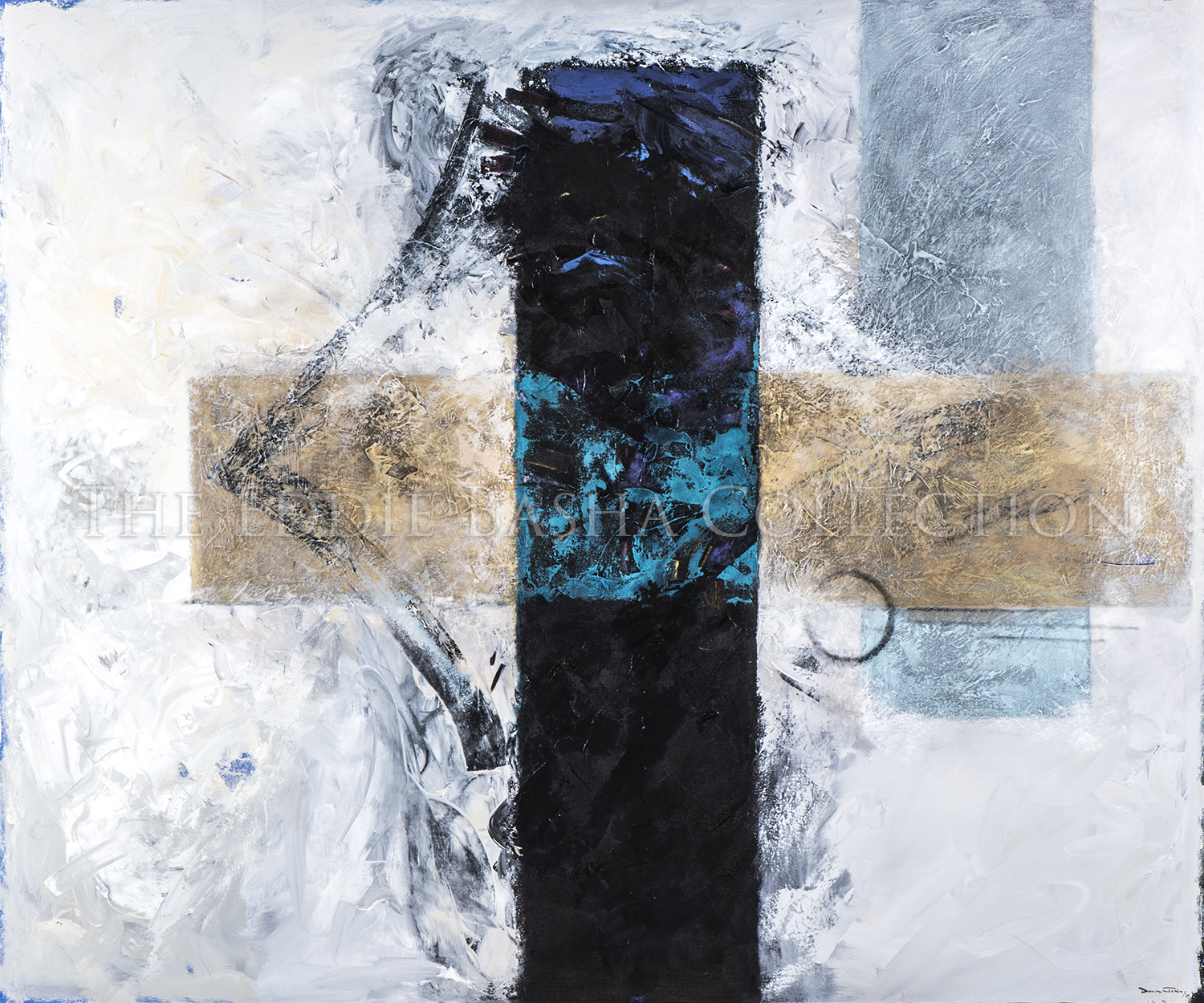
Colors of Stability
Artist: David Johns (b. 1948)
Description: Acrylic on Canvas | Image Size: 60”h x 72”w; Stretcher bar mounting/unframedpainting
The four cardinal directions among Indian Nations are very common, as are the four seasons and colors. According to the Diné, or Navajo, white represents the east, spring and the early dawn. Blue represents the south, the summer and the blue sky. Yellow represents the west, the fall and the evening. Black represents the north, the winter and the night.
Landscape Arizona
Artist: David Johns (b. 1948)
Description: Acrylic | Image Size: 60”h x 60”w; Unframedpainting
David Johns painting is an abstract landscape explosion of all that is between the viewer’s eye and the clearly defined horizon at the top! His use of color defines the desert floor and foliage, the wonders of mountain peaks and valleys, the crystal waters of lakes and streams and the sun’s path as it makes its way across the sky. The wonders of nature are ours to explore and protect.
Johns work can be found in museums and private collections worldwide.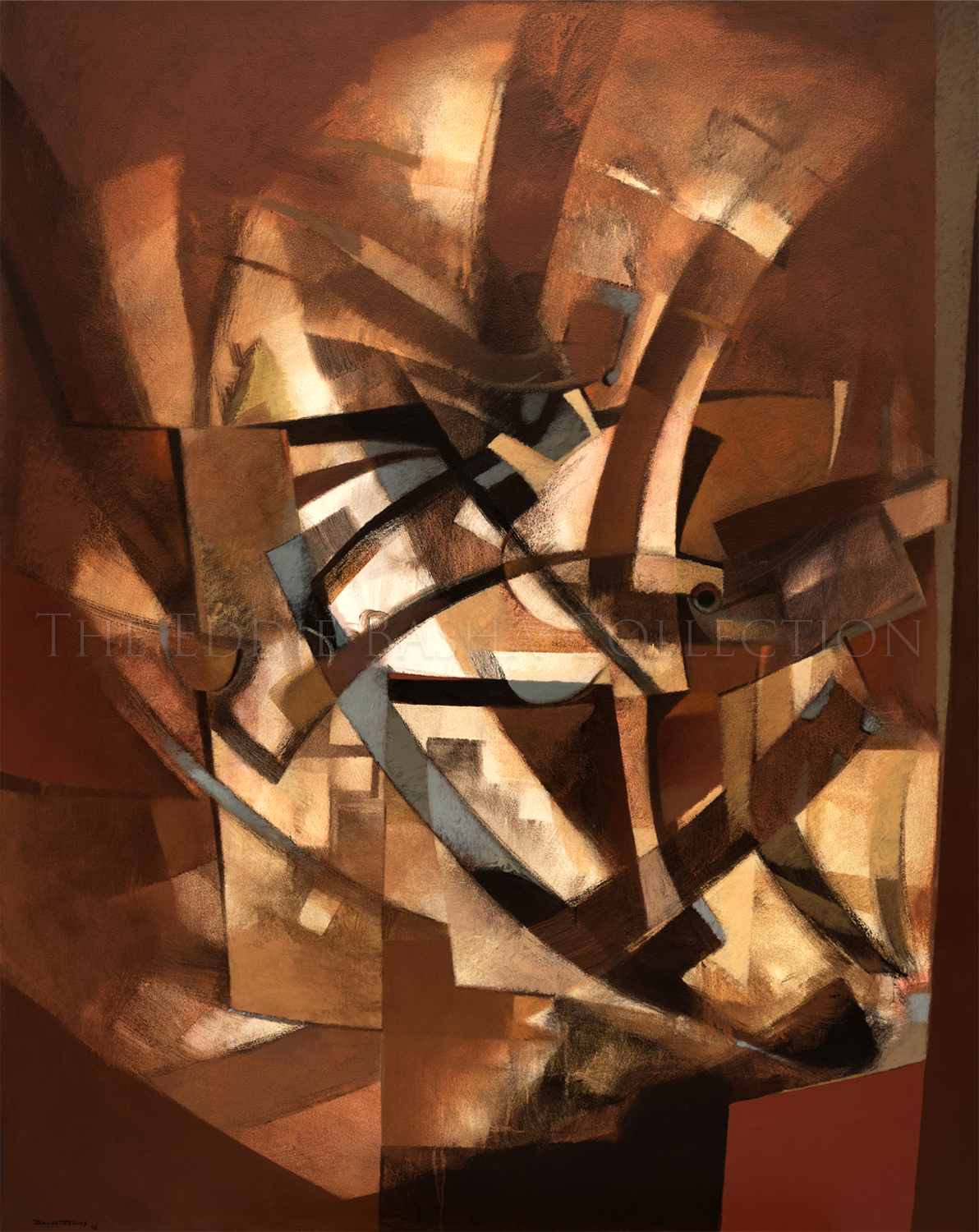
Round Dance
Artist: David Johns (b. 1948)
Description: Acrylic | Dimensions: 66”h x 52”w; Unframed on Stretcher Barspainting
Originally, the purpose of a traditional American Indian Round Dance was to honor the newly deceased. It was also intended to aid the deceased’s family in its grief surrounded by the love and support of others. Through the years the evolution of the Round Dance now includes ceremonials, celebratory events such as holidays, birthdays, graduations, weddings, anniversaries, or as a community social activity. Everyone is encouraged to participate as part of the circle signifying equality and that each participant is an important part of the whole collective.
In David John’s abstract perspective of a Round Dance, the dancers are in full motion keeping in time with the beating of the drums. The earthen colors are symbolic … we are all children of the earth.
David’s work can be found in numerous private collections as well as various museums internationally.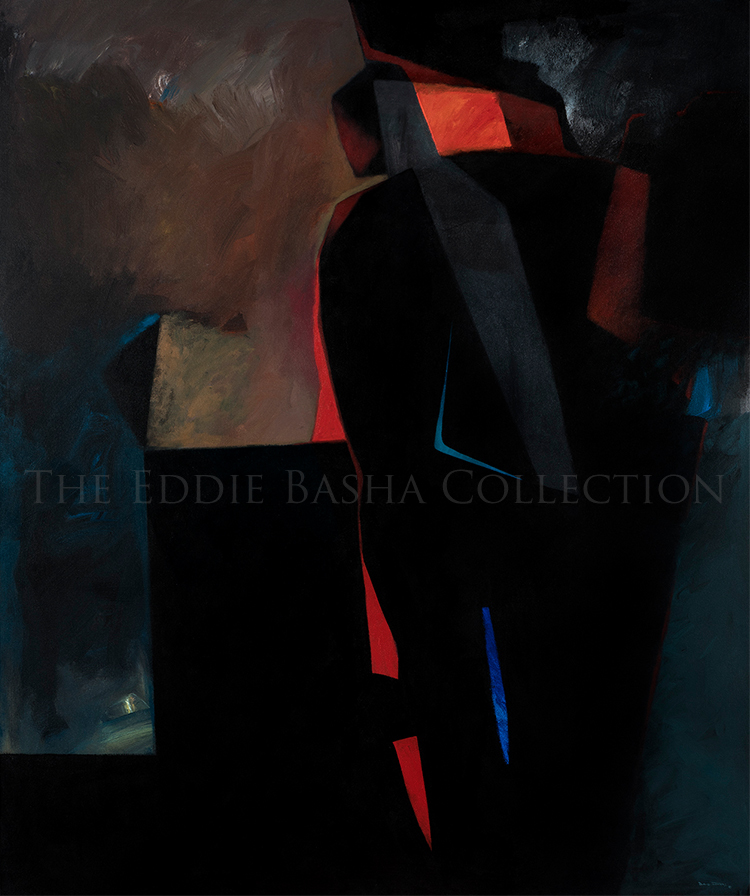
Couple Fire Dance
Artist: David Johns (b. 1948)
Description: Acrylic | 72”h x 60”wpainting
David Johns is a Vice President of the Diné Hataałii Association, an organization of Navajo Medicine Men and Women. Couple Fire Dance is his abstract perspective of the Diné Ceremony performed for healing and purification. Ceremonial dances are typically performed during the long winter nights.
Though David’s masterworks can be found in museums and private collections worldwide, one of the more spectacular viewings is of a mural he painted in 1987 which can be found under the dome at Concord Place in Phoenix. The mural is thirty-six feet in diameter and rises 50 feet; it took 18 months to paint. The mural depicts native peoples in all four directions, presents indigenous designs and symbols, and portraits of great leaders such as Crazy Horse and Quanah Parker. Noted author N. Scott Momaday wrote, "David Johns is a seer, and he comes very honestly by that gift. In his remarkable artwork, he enables us to see as well. His gift becomes our gift. Here is the essential spirit of creation."
Johns earned his bachelor’s degree in fine arts at Northern Arizona University. Subsequently, he was awarded an Honorary Doctorate Degree in Humane Letters from the same university.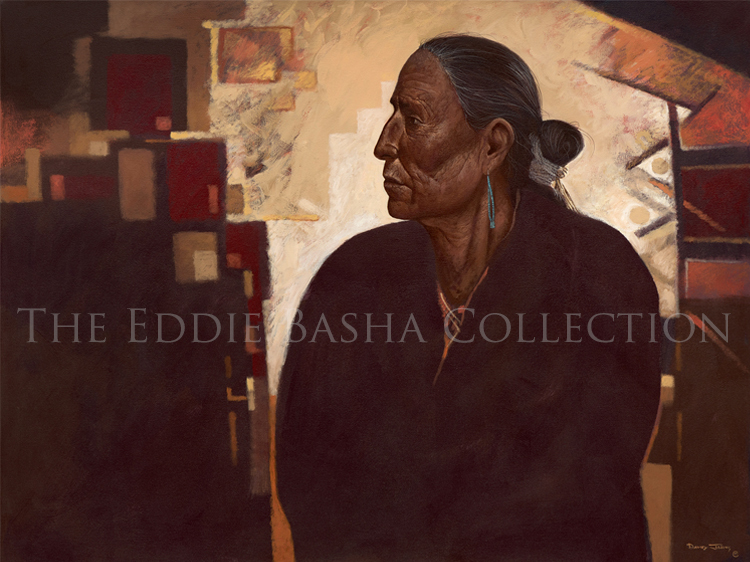
Portrait of Diné Woman
Artist: David Johns (b. 1948)
Description: Acrylic on Canvas (1997) | Image Size: 36”h x 48”w; Unframed/Stretcher Barspainting
Often incorporating abstract elements as well as realism in his work, here David Johns has nestled a Diné weaver’s contemplative portrait within his perception of her creative process.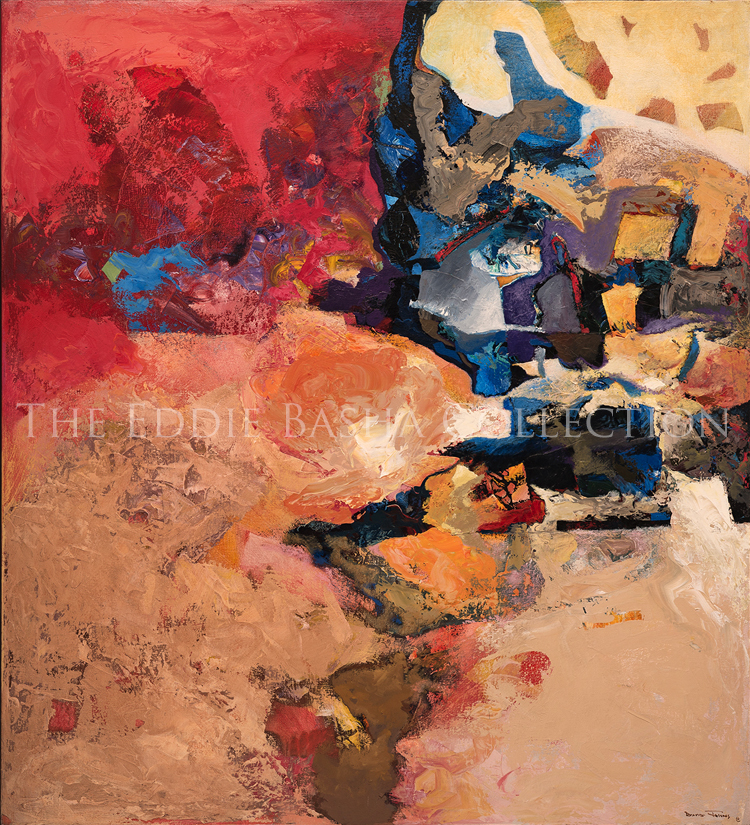
Shadows
Artist: David Johns (b. 1948)
Description: Acrylic on Canvas (2004) | Image Size: 44”h x 40”w; Unframed/Stretcher Barspainting
“My creations on paper or canvas do not come from a place of preconception. They come from the inner most chamber of my soul. The essence of what I am is a spiritual being. I am a Diné (Navajo) man of the Tl’a’a’shchi’I’ clan and born for the Kiiya’’aannii clan. Evan as I write it, it feels like I am saying a prayer.
Everything I am and do I hope comes from a place of harmony. If my mind, body and spirit are in balance then I can produce an image which reflects my truth. I hope my abstractions are ways for the observer to feel the essence of my inner self; not to get caught up in the distractions of outer appearances. It is not the form that touches our deepest longings, but rather the story my images evoke in the viewer. This is the ultimate impact of my art,” opined David Johns.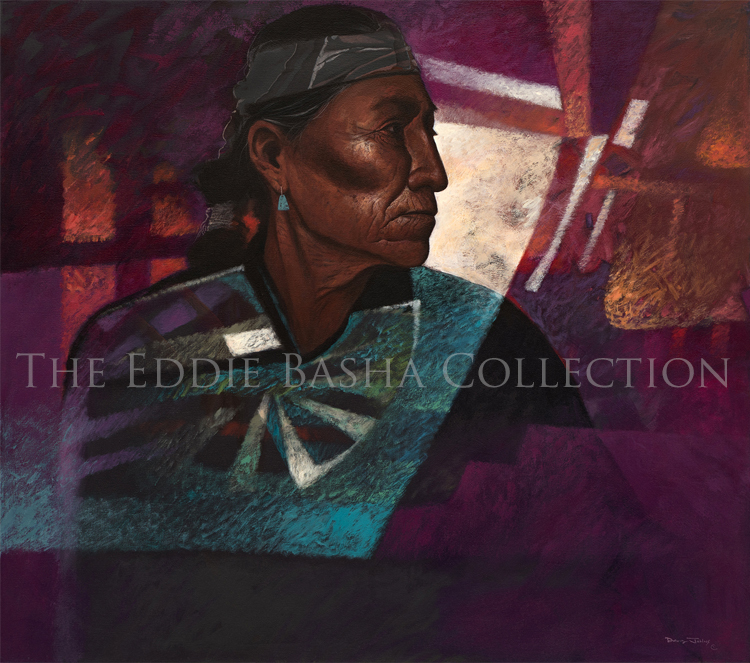
Imagery of Dine’
Artist: David Johns (b. 1948)
Description: Acrylic on Canvas (1997) | Image Size: 39”h x 44”w; Unframedpainting
In his own inimitable style, David Johns’ portraits of the Diné, the Navajo people, the central figure representationally appears to be reflective of the past, having purpose in the present, and aspiration for the future.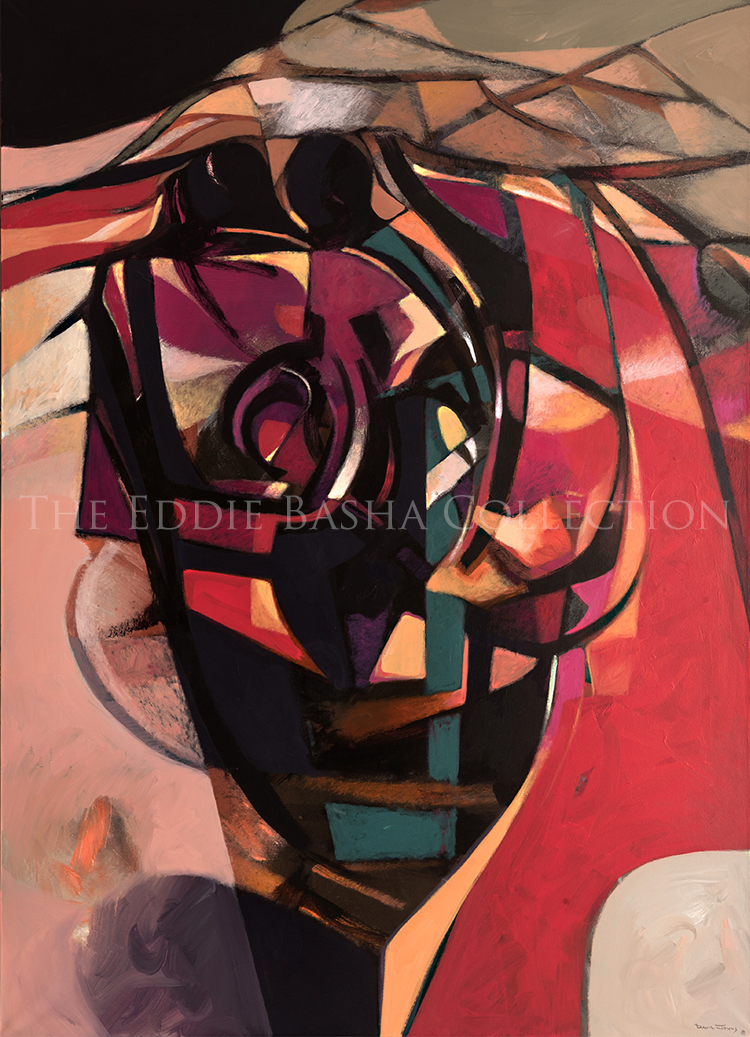
Couple Series #6
Artist: David Johns (b. 1948)
Description: Acrylic on Canvas (1995) | Image Size: 57”h x 42”w; Unframedpainting
“I hope my abstractions are ways for the observers to feel the essence of my inner self; not get caught up in the distractions of outer appearances. It is not the form that touches our deepest longings but rather the story my images evoke in the viewer. This is the ultimate impact of my art.”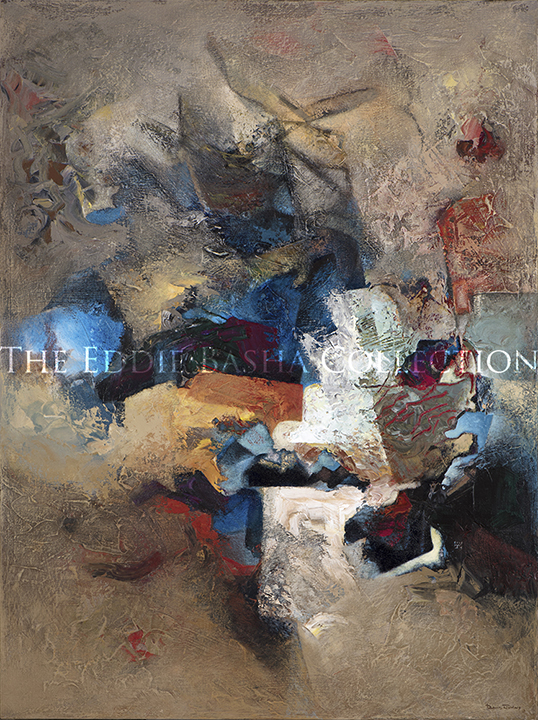
Reattachment
Artist: David Johns (b. 1948)
Description: Acrylic (2004) | Image Size: 30”w x 40”h; Unframedpainting
Loyalty
Artist: David Johns (b. 1948)
painting
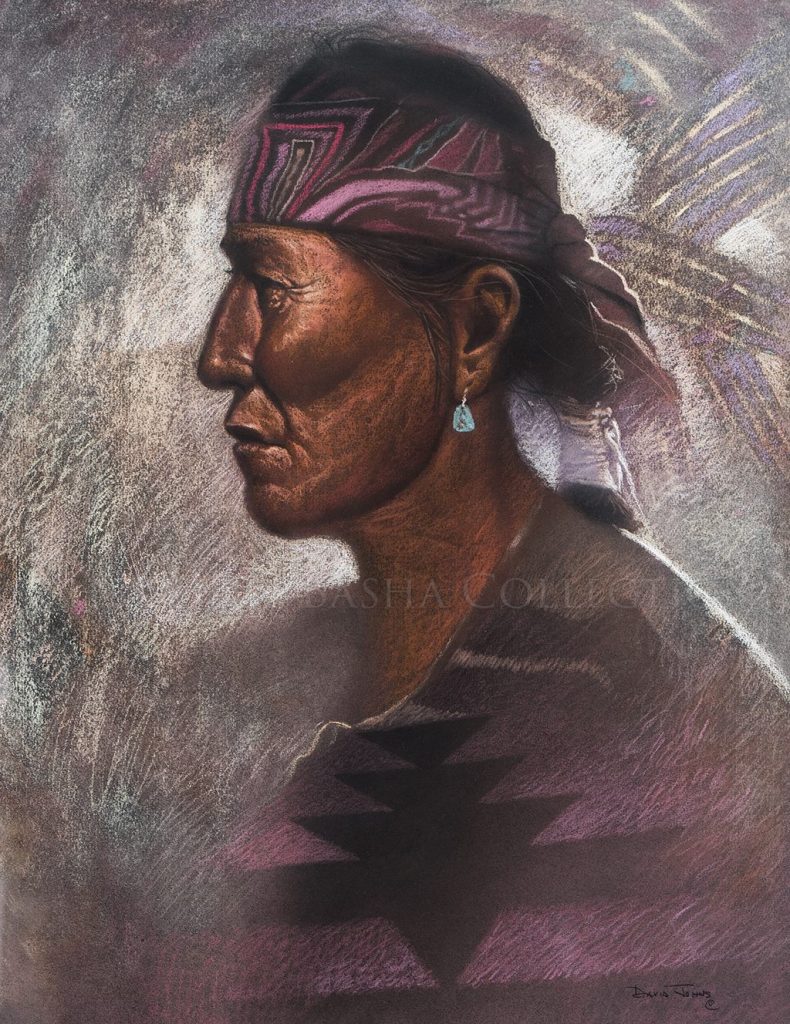 Pastel | Image Size: 24”h x 19”w; Framed Size: 32 ½"h x 27 ¼"w
Pastel | Image Size: 24”h x 19”w; Framed Size: 32 ½"h x 27 ¼"w This pastel portrait by David Johns features a somewhat elderly yet strong Navajo male profile whose face shows telltale signs of spending time outdoors as evidenced by the deepened tones of his complexion. It also includes hints of the subject’s celebration of his culture as noted by both the strong symbolism shown in his head wrap and the blanket he is swathed in. The turquoise drop earring takes center stage and is another celebration of culture which dates back centuries. Earrings can denote tribal identity, an individual’s spirituality, and are often worn during other traditional rituals such as a coming of age or rite of passage ceremonies which still take place today.
Unknown Title
Artist: David Johns (b. 1948)
This pastel portrait by David Johns features a somewhat elderly yet strong Navajo male profile whose face shows telltale signs of spending time outdoors as evidenced by the deepened tones of his complexion. It also includes hints of the subject’s celebration of his culture as noted by both the strong symbolism shown in his head wrap and the blanket he is swathed in. The turquoise drop earring takes center stage and is another celebration of culture which dates back centuries. Earrings can denote tribal identity, an individual’s spirituality, and are often worn during other traditional rituals such as a coming of age or rite of passage ceremonies which still take place today.
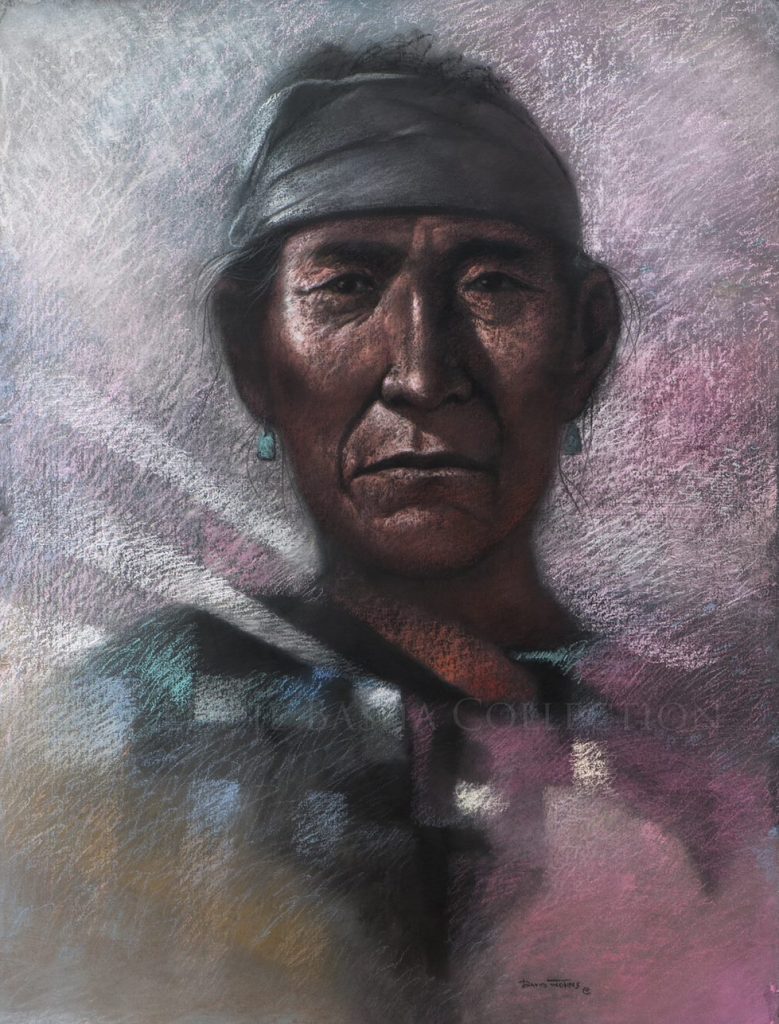 Pastel | Image Size: 30”h x 22”w; Framed Size: 45”h x 38”w
Pastel | Image Size: 30”h x 22”w; Framed Size: 45”h x 38”w “My creations on paper or canvas do not come from a place of preconception. They come from the inner most chamber of my soul. The essence of what I am is a spiritual being. I am a Diné (Navajo) man of the Tl’a’a’shchi’I’ clan and born for the Kiiya’’aannii clan. Even as I write it, it feels like I am saying a prayer.
Everything I am and do I hope comes from a place of harmony. If my mind, body and spirit are in balance then I can produce an image which reflects my truth. I hope my abstractions are ways for the observer to feel the essence of my inner self; not to get caught up in the distractions of outer appearances. It is not the form that touches our deepest longings, but rather the story my images evoke in the viewer. This is the ultimate impact of my art,” opined David Johns.
Unknown Title
Artist: David Johns (b. 1948)
“My creations on paper or canvas do not come from a place of preconception. They come from the inner most chamber of my soul. The essence of what I am is a spiritual being. I am a Diné (Navajo) man of the Tl’a’a’shchi’I’ clan and born for the Kiiya’’aannii clan. Even as I write it, it feels like I am saying a prayer.
Everything I am and do I hope comes from a place of harmony. If my mind, body and spirit are in balance then I can produce an image which reflects my truth. I hope my abstractions are ways for the observer to feel the essence of my inner self; not to get caught up in the distractions of outer appearances. It is not the form that touches our deepest longings, but rather the story my images evoke in the viewer. This is the ultimate impact of my art,” opined David Johns.
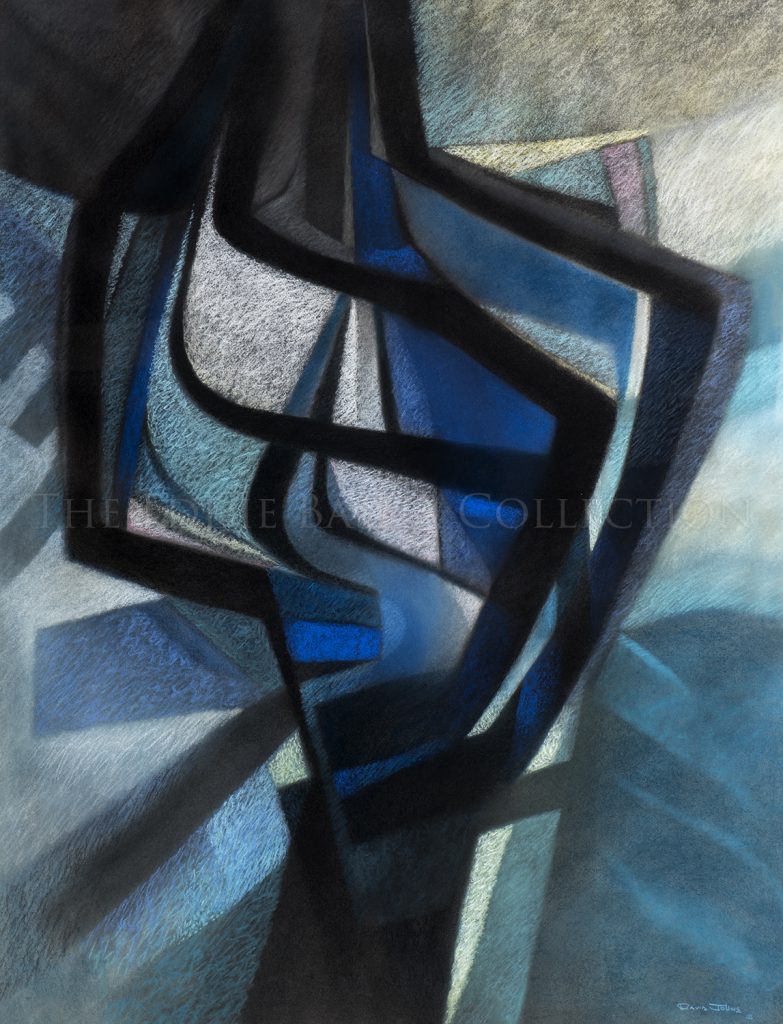 Pastel | Image Size: 38”h x 30”w; Framed Size: 46”h x 37”w
Pastel | Image Size: 38”h x 30”w; Framed Size: 46”h x 37”wDavid Johns is a prolific Navajo artist who moves easily between two distinct styles: representational portraits and abstracts. As a result, his work appeals to a wide range of collectors. Thus far, the EBC has only shared Johns’ work in acrylic and a few monotypes. Today it is our distinct pleasure to share this pastel abstract that remains a permanent part of the collection.
Figure in Robe
Artist: David Johns (b. 1948)
David Johns is a prolific Navajo artist who moves easily between two distinct styles: representational portraits and abstracts. As a result, his work appeals to a wide range of collectors. Thus far, the EBC has only shared Johns’ work in acrylic and a few monotypes. Today it is our distinct pleasure to share this pastel abstract that remains a permanent part of the collection.
 Monotype (2004) | Image Size: 30”h x 22”w”; Framed Size: 38 ½”h x 31”w
Monotype (2004) | Image Size: 30”h x 22”w”; Framed Size: 38 ½”h x 31”wJohns’ work is inspired by his Navajo culture, traditional healing practice, wisdom and being an herbalist. In the Navajo culture, Spider Woman is revered for sharing the wisdom, education and skills the first people needed to survive, such as planting crops and weaving.
Spider Woman’s Motifs #3
Artist: David Johns (b. 1948)
Johns’ work is inspired by his Navajo culture, traditional healing practice, wisdom and being an herbalist. In the Navajo culture, Spider Woman is revered for sharing the wisdom, education and skills the first people needed to survive, such as planting crops and weaving.
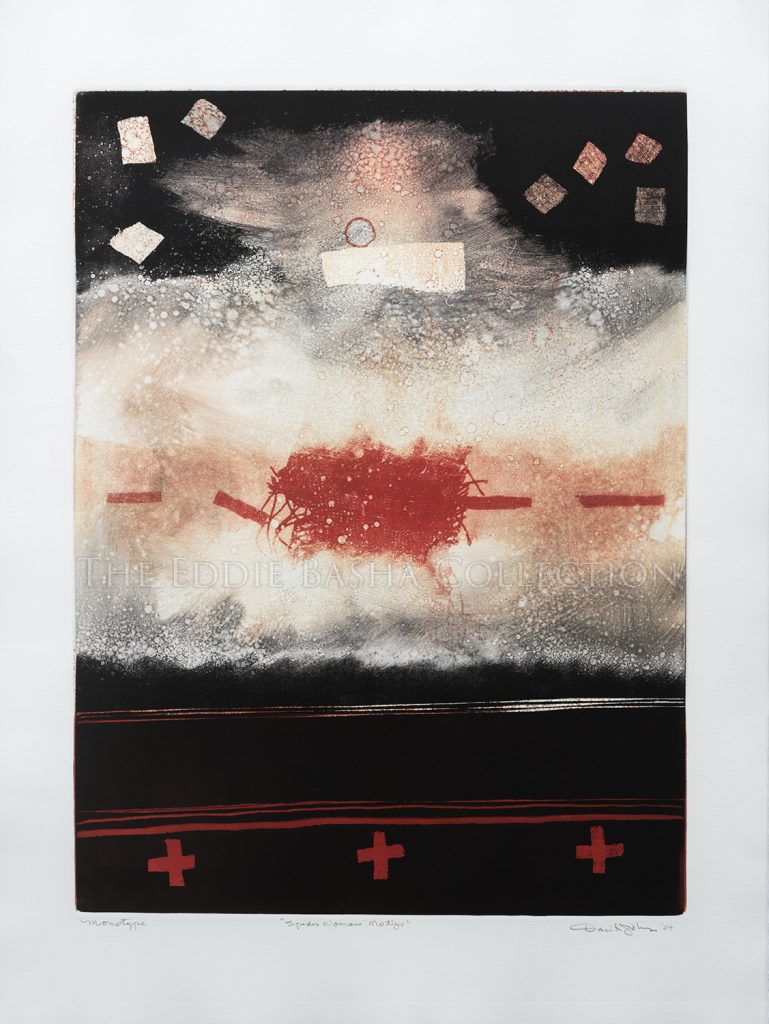 Monotype (2004) | Image Size: 30”h x 22”w”; Framed Size: 38 ½”h x 31”w
Monotype (2004) | Image Size: 30”h x 22”w”; Framed Size: 38 ½”h x 31”wJohns’ work is inspired by his Navajo culture, traditional healing practice, wisdom and being an herbalist. In the Navajo culture, Spider Woman is revered for sharing the wisdom, education and skills the first people needed to survive, such as planting crops and weaving.
Spider Woman’s Motifs #1
Artist: David Johns (b. 1948)
Johns’ work is inspired by his Navajo culture, traditional healing practice, wisdom and being an herbalist. In the Navajo culture, Spider Woman is revered for sharing the wisdom, education and skills the first people needed to survive, such as planting crops and weaving.
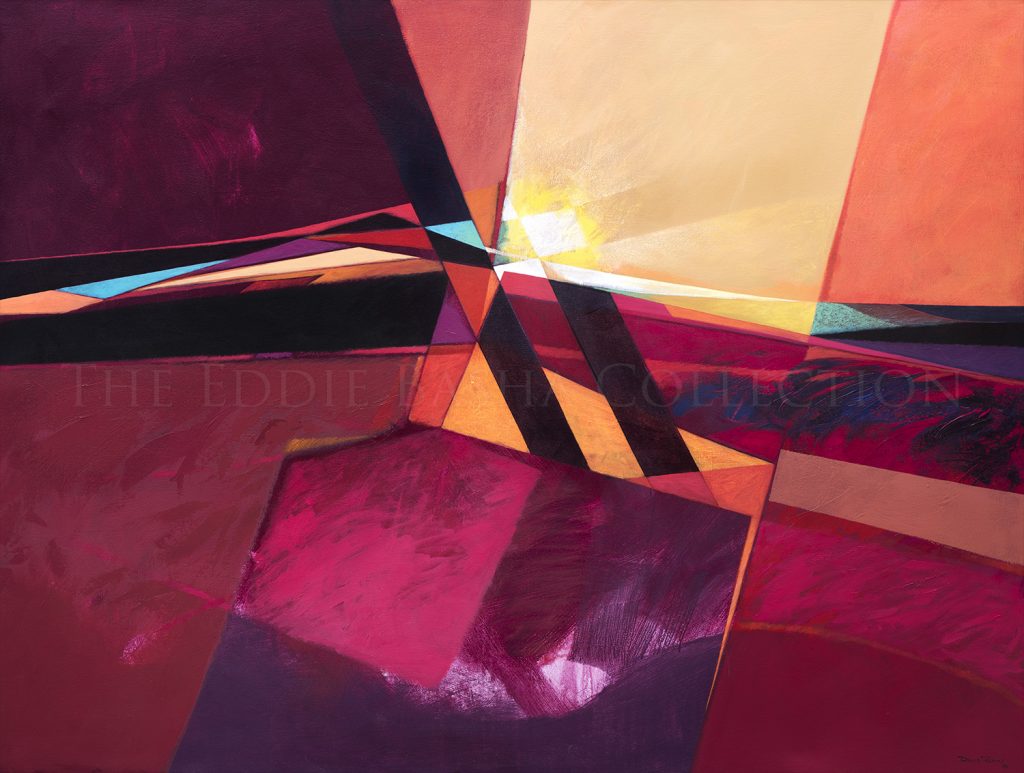 Acrylic | Dimensions: 54”h x 72”w; mounted on stretcher bars
Acrylic | Dimensions: 54”h x 72”w; mounted on stretcher bars Another vibrant, abstract masterwork titled “Landscape” by Navajo artist, David Johns, features the brilliant colors of a glorious sunset descending beyond the mountain tops.
Landscape
Artist: David Johns (b. 1948)
Another vibrant, abstract masterwork titled “Landscape” by Navajo artist, David Johns, features the brilliant colors of a glorious sunset descending beyond the mountain tops.
 Acrylic (1990) | Image Size: 44”h x 70”w; mounted on stretcher bars
Acrylic (1990) | Image Size: 44”h x 70”w; mounted on stretcher barsIn the book, “David Johns: On the Trail of Beauty” written by Lois Essary Jacka published in 1991, David John’s shared the following about this piece: “It expresses emotion when alone in the great outdoors. A sense of serenity comes with the silence, the gently shifting sands, the muted call of a bird, the sigh of the wind. Yet with the serenity comes the feeling that someone, perhaps an ever watchful spirit, is close at hand.”
Alone
Artist: David Johns (b. 1948)
In the book, “David Johns: On the Trail of Beauty” written by Lois Essary Jacka published in 1991, David John’s shared the following about this piece: “It expresses emotion when alone in the great outdoors. A sense of serenity comes with the silence, the gently shifting sands, the muted call of a bird, the sigh of the wind. Yet with the serenity comes the feeling that someone, perhaps an ever watchful spirit, is close at hand.”
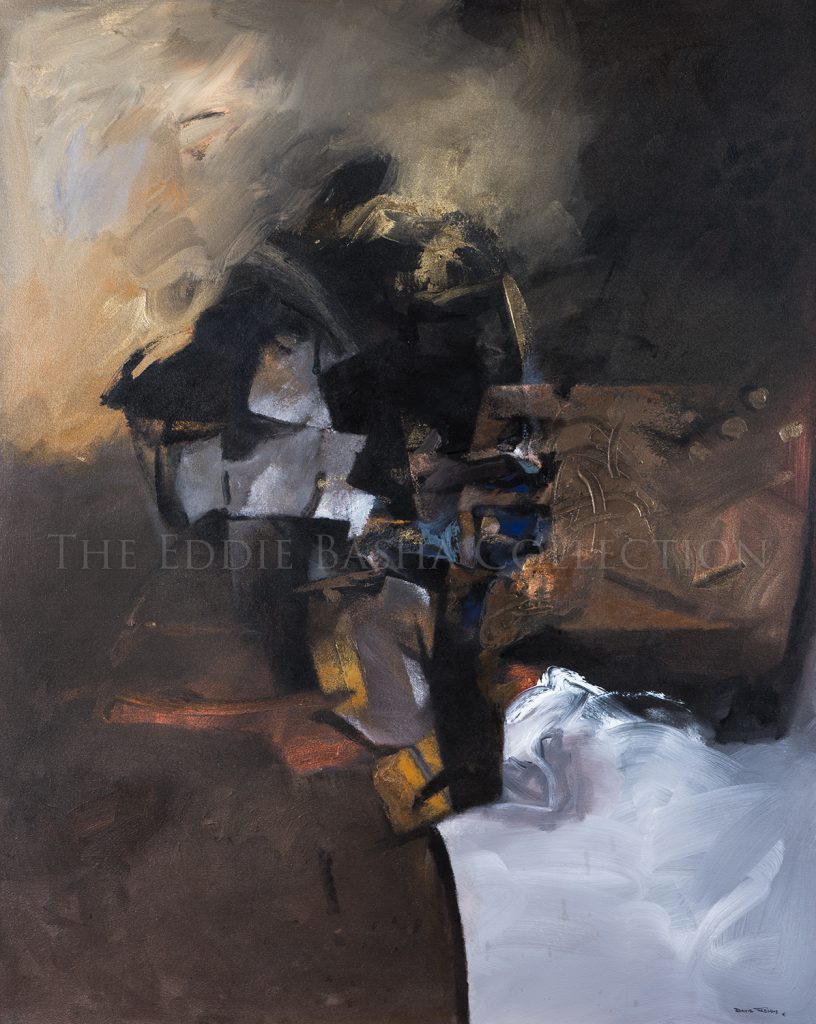 Acrylic on Canvas | Image Size: 60”h x 48”w; mounted on stretcher bars
Acrylic on Canvas | Image Size: 60”h x 48”w; mounted on stretcher barsDavid Johns shared that his masterwork “Manifestation Insight” was a compilation of stories pertaining to the stars that give us knowledge, wisdom, sensory perception and auditory projection.
Johns’ work is inspired by his Navajo culture, traditional healing practice, wisdom and being an herbalist.
Manifestation Insight
Artist: David Johns (b. 1948)
David Johns shared that his masterwork “Manifestation Insight” was a compilation of stories pertaining to the stars that give us knowledge, wisdom, sensory perception and auditory projection.
Johns’ work is inspired by his Navajo culture, traditional healing practice, wisdom and being an herbalist.
 Acrylic on Canvas | Image Size: 60”h x 72”w; Stretcher bar mounting/unframed
Acrylic on Canvas | Image Size: 60”h x 72”w; Stretcher bar mounting/unframedThe four cardinal directions among Indian Nations are very common, as are the four seasons and colors. According to the Diné, or Navajo, white represents the east, spring and the early dawn. Blue represents the south, the summer and the blue sky. Yellow represents the west, the fall and the evening. Black represents the north, the winter and the night.
Colors of Stability
Artist: David Johns (b. 1948)
The four cardinal directions among Indian Nations are very common, as are the four seasons and colors. According to the Diné, or Navajo, white represents the east, spring and the early dawn. Blue represents the south, the summer and the blue sky. Yellow represents the west, the fall and the evening. Black represents the north, the winter and the night.
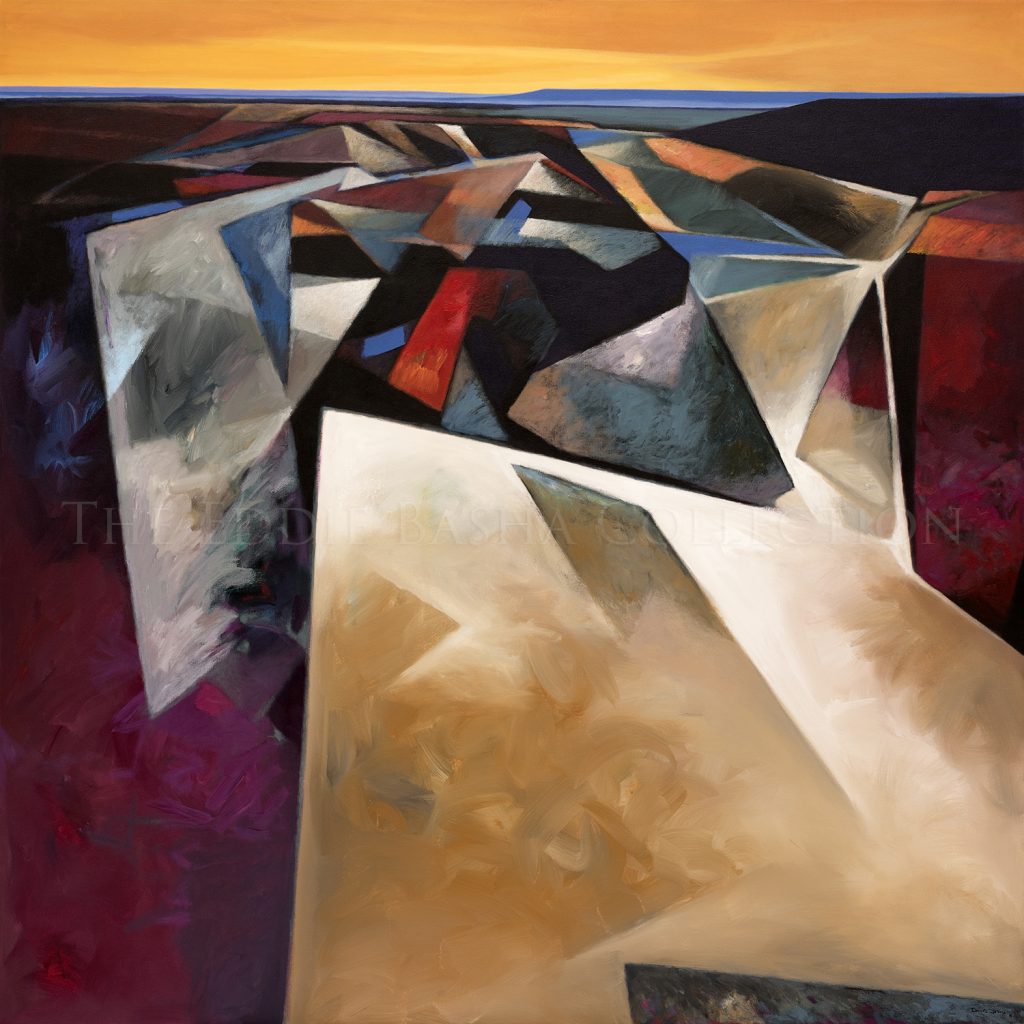 Acrylic | Image Size: 60”h x 60”w; Unframed
Acrylic | Image Size: 60”h x 60”w; UnframedDavid Johns painting is an abstract landscape explosion of all that is between the viewer’s eye and the clearly defined horizon at the top! His use of color defines the desert floor and foliage, the wonders of mountain peaks and valleys, the crystal waters of lakes and streams and the sun’s path as it makes its way across the sky. The wonders of nature are ours to explore and protect.
Johns work can be found in museums and private collections worldwide.
Landscape Arizona
Artist: David Johns (b. 1948)
David Johns painting is an abstract landscape explosion of all that is between the viewer’s eye and the clearly defined horizon at the top! His use of color defines the desert floor and foliage, the wonders of mountain peaks and valleys, the crystal waters of lakes and streams and the sun’s path as it makes its way across the sky. The wonders of nature are ours to explore and protect.
Johns work can be found in museums and private collections worldwide.
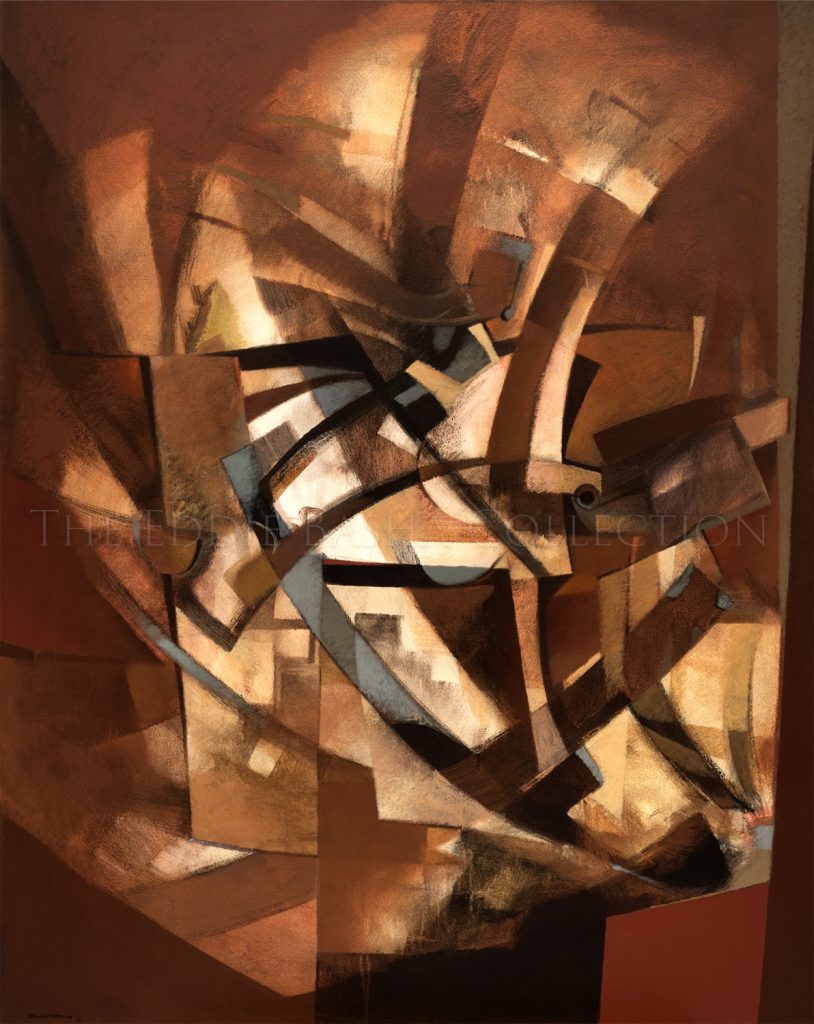 Acrylic | Dimensions: 66”h x 52”w; Unframed on Stretcher Bars
Acrylic | Dimensions: 66”h x 52”w; Unframed on Stretcher BarsOriginally, the purpose of a traditional American Indian Round Dance was to honor the newly deceased. It was also intended to aid the deceased’s family in its grief surrounded by the love and support of others. Through the years the evolution of the Round Dance now includes ceremonials, celebratory events such as holidays, birthdays, graduations, weddings, anniversaries, or as a community social activity. Everyone is encouraged to participate as part of the circle signifying equality and that each participant is an important part of the whole collective.
In David John’s abstract perspective of a Round Dance, the dancers are in full motion keeping in time with the beating of the drums. The earthen colors are symbolic … we are all children of the earth.
David’s work can be found in numerous private collections as well as various museums internationally.
Round Dance
Artist: David Johns (b. 1948)
Originally, the purpose of a traditional American Indian Round Dance was to honor the newly deceased. It was also intended to aid the deceased’s family in its grief surrounded by the love and support of others. Through the years the evolution of the Round Dance now includes ceremonials, celebratory events such as holidays, birthdays, graduations, weddings, anniversaries, or as a community social activity. Everyone is encouraged to participate as part of the circle signifying equality and that each participant is an important part of the whole collective.
In David John’s abstract perspective of a Round Dance, the dancers are in full motion keeping in time with the beating of the drums. The earthen colors are symbolic … we are all children of the earth.
David’s work can be found in numerous private collections as well as various museums internationally.
 Acrylic | 72”h x 60”w
Acrylic | 72”h x 60”wDavid Johns is a Vice President of the Diné Hataałii Association, an organization of Navajo Medicine Men and Women. Couple Fire Dance is his abstract perspective of the Diné Ceremony performed for healing and purification. Ceremonial dances are typically performed during the long winter nights.
Though David’s masterworks can be found in museums and private collections worldwide, one of the more spectacular viewings is of a mural he painted in 1987 which can be found under the dome at Concord Place in Phoenix. The mural is thirty-six feet in diameter and rises 50 feet; it took 18 months to paint. The mural depicts native peoples in all four directions, presents indigenous designs and symbols, and portraits of great leaders such as Crazy Horse and Quanah Parker. Noted author N. Scott Momaday wrote, "David Johns is a seer, and he comes very honestly by that gift. In his remarkable artwork, he enables us to see as well. His gift becomes our gift. Here is the essential spirit of creation."
Johns earned his bachelor’s degree in fine arts at Northern Arizona University. Subsequently, he was awarded an Honorary Doctorate Degree in Humane Letters from the same university.
Couple Fire Dance
Artist: David Johns (b. 1948)
David Johns is a Vice President of the Diné Hataałii Association, an organization of Navajo Medicine Men and Women. Couple Fire Dance is his abstract perspective of the Diné Ceremony performed for healing and purification. Ceremonial dances are typically performed during the long winter nights.
Though David’s masterworks can be found in museums and private collections worldwide, one of the more spectacular viewings is of a mural he painted in 1987 which can be found under the dome at Concord Place in Phoenix. The mural is thirty-six feet in diameter and rises 50 feet; it took 18 months to paint. The mural depicts native peoples in all four directions, presents indigenous designs and symbols, and portraits of great leaders such as Crazy Horse and Quanah Parker. Noted author N. Scott Momaday wrote, "David Johns is a seer, and he comes very honestly by that gift. In his remarkable artwork, he enables us to see as well. His gift becomes our gift. Here is the essential spirit of creation."
Johns earned his bachelor’s degree in fine arts at Northern Arizona University. Subsequently, he was awarded an Honorary Doctorate Degree in Humane Letters from the same university.
 Acrylic on Canvas (1997) | Image Size: 36”h x 48”w; Unframed/Stretcher Bars
Acrylic on Canvas (1997) | Image Size: 36”h x 48”w; Unframed/Stretcher BarsOften incorporating abstract elements as well as realism in his work, here David Johns has nestled a Diné weaver’s contemplative portrait within his perception of her creative process.
Portrait of Diné Woman
Artist: David Johns (b. 1948)
Often incorporating abstract elements as well as realism in his work, here David Johns has nestled a Diné weaver’s contemplative portrait within his perception of her creative process.
 Acrylic on Canvas (2004) | Image Size: 44”h x 40”w; Unframed/Stretcher Bars
Acrylic on Canvas (2004) | Image Size: 44”h x 40”w; Unframed/Stretcher Bars“My creations on paper or canvas do not come from a place of preconception. They come from the inner most chamber of my soul. The essence of what I am is a spiritual being. I am a Diné (Navajo) man of the Tl’a’a’shchi’I’ clan and born for the Kiiya’’aannii clan. Evan as I write it, it feels like I am saying a prayer.
Everything I am and do I hope comes from a place of harmony. If my mind, body and spirit are in balance then I can produce an image which reflects my truth. I hope my abstractions are ways for the observer to feel the essence of my inner self; not to get caught up in the distractions of outer appearances. It is not the form that touches our deepest longings, but rather the story my images evoke in the viewer. This is the ultimate impact of my art,” opined David Johns.
Shadows
Artist: David Johns (b. 1948)
“My creations on paper or canvas do not come from a place of preconception. They come from the inner most chamber of my soul. The essence of what I am is a spiritual being. I am a Diné (Navajo) man of the Tl’a’a’shchi’I’ clan and born for the Kiiya’’aannii clan. Evan as I write it, it feels like I am saying a prayer.
Everything I am and do I hope comes from a place of harmony. If my mind, body and spirit are in balance then I can produce an image which reflects my truth. I hope my abstractions are ways for the observer to feel the essence of my inner self; not to get caught up in the distractions of outer appearances. It is not the form that touches our deepest longings, but rather the story my images evoke in the viewer. This is the ultimate impact of my art,” opined David Johns.
 Acrylic on Canvas (1997) | Image Size: 39”h x 44”w; Unframed
Acrylic on Canvas (1997) | Image Size: 39”h x 44”w; UnframedIn his own inimitable style, David Johns’ portraits of the Diné, the Navajo people, the central figure representationally appears to be reflective of the past, having purpose in the present, and aspiration for the future.
Imagery of Dine’
Artist: David Johns (b. 1948)
In his own inimitable style, David Johns’ portraits of the Diné, the Navajo people, the central figure representationally appears to be reflective of the past, having purpose in the present, and aspiration for the future.
 Acrylic on Canvas (1995) | Image Size: 57”h x 42”w; Unframed
Acrylic on Canvas (1995) | Image Size: 57”h x 42”w; Unframed“I hope my abstractions are ways for the observers to feel the essence of my inner self; not get caught up in the distractions of outer appearances. It is not the form that touches our deepest longings but rather the story my images evoke in the viewer. This is the ultimate impact of my art.”
Couple Series #6
Artist: David Johns (b. 1948)
“I hope my abstractions are ways for the observers to feel the essence of my inner self; not get caught up in the distractions of outer appearances. It is not the form that touches our deepest longings but rather the story my images evoke in the viewer. This is the ultimate impact of my art.”